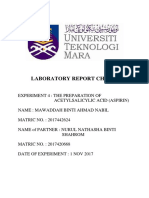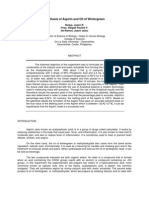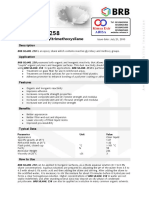Preparation of Aspirin in Lab
Preparation of Aspirin in Lab
Uploaded by
Muhammad Sanan JavedCopyright:
Available Formats
Preparation of Aspirin in Lab
Preparation of Aspirin in Lab
Uploaded by
Muhammad Sanan JavedOriginal Description:
Original Title
Copyright
Available Formats
Share this document
Did you find this document useful?
Is this content inappropriate?
Copyright:
Available Formats
Preparation of Aspirin in Lab
Preparation of Aspirin in Lab
Uploaded by
Muhammad Sanan JavedCopyright:
Available Formats
Preparation of Aspirin in Lab
Many compounds obtained from nature have been used to cure ills or to produce
an effect in humans. These natural products have been obtained from plants,
minerals, and animals. In addition, various transformations of these and other
compounds have led to even more medically useful compounds. Analgesics are
compounds used to reduce pain, antipyretics are compounds used to reduce fever.
One popular drug that does both is aspirin. The Merck Index, which is an
encyclopedia of chemicals, drugs and biologicals, lists the following information
under aspirin: acetylsalicylic acid; monoclinic tablets or needle-like crystals; mp
135 °C (rapid heating); is odorless, but in moist air it is gradually hydrolyzed into
salicylic and acetic acids;.
synthesis of aspirin by reacting excess acetic anhydride with a determined mass of 2-
hydroxybenzoic acid which is also known as salicylic acid in the presence of an acid catalyst
which was concentrated sulfuric acid. Aspirin belongs to the family of organic compounds
known as esters and is an acetyl derivative of salicylic acid. The esterification process involves
the reaction of a carboxyl group with a phenol group and the reaction is reversible.
Aspirin is one of the most inexpensive, yet safest pain-killers available in today’s market, with
approximately 35,000 metric tons of consumption annually. It has analgesic, antipyretic and anti-
inflammatory properties which could be used to treat fevers, minor pains, discomfort and
lowering of inflammation in the body. The salicylic acid extracted straight from these plants
were unfortunately too harsh for oral ingestion.
SYNTHESIS OF ASPIRIN (acetylsalicylic acid)
Mechanism of aspirin synthesis
Procedure
1. Place 1.5 g – 2g of salicylic acid in a 125-mL Erlenmeyer flask.
2. Add 5 mL (0.05 mole) of acetic anhydride, followed by 5 drops of conc.
H2SO4 (use a dropper, H2SO4 is highly corrosive) and swirl the flask gently
until the salicylic acid dissolves.
3. Heat the flask gently on the steam bath for at least 10 minutes.
4. Allow the flask to cool to room temperature. If acetylsalicylic acid does not
begin to crystallize out, scratch the walls of the flask with a glass rod. Cool
the mixture slightly in an ice bath until crystallization is completed. The
product will appear as a solid mass when crystallization is completed.
5. Add 50 mL or 100ml of water and cool the mixture in an ice bath. Do not
add the water until crystal formation is complete.
6. Vacuum filter the product using a Buchner funnel. You can use some of the
filtrate to rinse the Erlenmeyer flask if necessary.
7. Rinse the crystals several times with small portions (5 mL) of cold water and
air dry the crystals on a Buchner funnel by suction until the crystals appear
to be free of solvent. Test this crude product for the presence of unreacted
salicylic acid using the ferric chloride test. Record the weight of the crude
solid which probably contains water.
8. Stir the crude solid with 25 mL of a saturated aqueous sodium bicarbonate
solution in a 150 mL beaker until all signs of reaction have ceased (evolution
of CO2 ceases).
9. Filter the solution through a Buchner funnel to remove any insoluble
impurities or polymers that may have been formed. Wash the beaker and the
funnel with 5 to 10 mL of water.
10. Carefully pour the filtrate with stirring, a small amount at a time, into an ice
cold HCl solution (ca 3.5 mL of conc. HCl in 10 mL of water) in a 150-mL
beaker and cool the mixture in an ice bath. Make sure that the resulting
solution is acidic (blue litmus paper) and that the aspirin has completely
precipitated out.
11. Filter the solid by suction and wash the crystals with 5 mL of cold water
each. Remove all the liquid from the crystals by pressing with a clean
stopper or cork. Air dry the crystals and transfer them to a watch glass to
dry. Test a small amount of the product for the presence of unreacted
salicylic acid using the ferric chloride solution.
12. When the product is completely dry, weigh the product, determine its
melting point (lit mp 135-136 °C) and calculate the percentage yield.
FERRIC CHLORIDE TEST FOR SALICYLIC ACID
Add 10 drops of aqueous 1% ferric chloride solution to a test tube containing a few
crystals of the compound to be tested dissolved in 5 mL water and note the color.
Do this test with 1.phenol, 2. salicylic acid, and 3. your crude product. Formation
of an iron-phenol complex with Fe(lll) gives a definite color ranging from red to
violet, depending upon the particular phenol present.
Calculations: a) Calculate the Mr (relative molecular mass) of the substances.
Ar : C = 12, H = 1, O = 16 So,
Mr : • Salicylic acid = C7O3H6 = (12x7)+(16x3)+(6x1) = 138 g
• Ethanoic Anhydride = C4O3H6 = (12x4)+(16x3)+(6x1) = 102 g
• Aspirin = C9O4H8 = (12x9)+(16x4)+(8x1) =180 g
b) Change the grams to moles for salicylic acid to calculate moles
Salicylic acid= 1.5 g. 1.5 ÷ 138 = 0.01086 moles
c) Calculate the mass of Ethanoic Anhydride
The density is 1.082 g/cm3 1.082 x 5 = 5.41 g 5.41/102= 0.0442moles
d) Which chemical compound is the Limiting Reagent:
1 mole: 1 mole ratio
The same values 0.0186: 0.0442
The lowest value is the Limiting Reagent which is Salicylic Acid
e) Calculate the Theoretical yield mass in grams for Aspirin Salicylic Acid mole
value multiply by Aspirin molecular mass 0.01086 x 180 = 1.9548 g
f) Calculate the Percent Yield.
%Yield = Actual Yield of Aspirin / (g) Theoretical Yield of Aspirin (g) × 100%
The actual mass obtained of Aspirin is 0.686 g
so, the percent yield = 0.686 ÷ 1.9548 × 100% = 35.09%
You might also like
- Aspirin ExperimentDocument7 pagesAspirin ExperimentTrương Thị Bích LiễuNo ratings yet
- Manual of Formulas - Recipes, Methods & Secret ProcessesFrom EverandManual of Formulas - Recipes, Methods & Secret ProcessesRating: 4.5 out of 5 stars4.5/5 (2)
- Science: Quarter 2 - Module 7 Percentage CompositionDocument31 pagesScience: Quarter 2 - Module 7 Percentage CompositionKristine Ibarreta-Jazul100% (3)
- AspirinDocument2 pagesAspirinJerel MarquezNo ratings yet
- 1 Synthesis of Aspirin (Experiment)Document2 pages1 Synthesis of Aspirin (Experiment)andrewriberakurora15No ratings yet
- New Microsoft Word DocumentDocument3 pagesNew Microsoft Word DocumentKumar AryanNo ratings yet
- Chapter 24 - Experiment B - Aspirin Synthesis and AnalysisDocument5 pagesChapter 24 - Experiment B - Aspirin Synthesis and AnalysisNeen NaazNo ratings yet
- Exp4 chm456Document8 pagesExp4 chm456Mawar AhmadNo ratings yet
- Synthesis of Acetylsalicylic AcidDocument7 pagesSynthesis of Acetylsalicylic Acidjeniccax17No ratings yet
- Synthesis and Analysis of Aspirin: Experiment 11Document4 pagesSynthesis and Analysis of Aspirin: Experiment 11Ruthanne TyxNo ratings yet
- Synthesis of Aspirin-Formal ReportDocument6 pagesSynthesis of Aspirin-Formal ReportStephanie ButedNo ratings yet
- Cbse Xii Chemistry Project Preparation of Aspirin and AcetaminophenDocument7 pagesCbse Xii Chemistry Project Preparation of Aspirin and AcetaminophenVasudevSingh57% (7)
- Chem-131 Lab-05 09-4 Synthesis of Aspirin (STD)Document2 pagesChem-131 Lab-05 09-4 Synthesis of Aspirin (STD)Sairee AbianNo ratings yet
- How To Make AspirinDocument7 pagesHow To Make Aspirinafzal4u100% (8)
- AspirinDocument12 pagesAspirinTUSHAR SAHUNo ratings yet
- Syntheis of AspirinDocument11 pagesSyntheis of AspirinrubyNo ratings yet
- Aspirin Chemistry ProjectDocument21 pagesAspirin Chemistry Projectakash10princeNo ratings yet
- Synthesis of Aspirin and Oil of WintergreenDocument5 pagesSynthesis of Aspirin and Oil of WintergreenJason Raquin Roque100% (4)
- Preparation of Aspirin and AcetaminophenDocument5 pagesPreparation of Aspirin and AcetaminophenArjav VashiNo ratings yet
- Aspirin & AnalgesicsDocument14 pagesAspirin & AnalgesicsJose CencičNo ratings yet
- Practical 5 1Document6 pagesPractical 5 1eclan7raphaelNo ratings yet
- Synthesis and Analysis of Aspirin: Experiment 11Document6 pagesSynthesis and Analysis of Aspirin: Experiment 11Nor Ashikin IsmailNo ratings yet
- ASPIRIN Project FileDocument8 pagesASPIRIN Project FileSumit SinhaNo ratings yet
- CHEM 165 Lab Manual Spring 2000Document41 pagesCHEM 165 Lab Manual Spring 2000Leon AFNo ratings yet
- Exp4 OrganicDocument7 pagesExp4 Organic2023389301No ratings yet
- Formal Report - AspirinDocument4 pagesFormal Report - AspirinMeah PachecoNo ratings yet
- Aspirin SynthesisDocument6 pagesAspirin SynthesisArash JoonNo ratings yet
- Chem Scientific PaperDocument4 pagesChem Scientific Paperfloz fowneNo ratings yet
- Ex4-Preparation of AspirinDocument6 pagesEx4-Preparation of AspirinKaran KapoorNo ratings yet
- asipirin organic lab reportDocument7 pagesasipirin organic lab reportElias BiramoNo ratings yet
- Org Lab Man S08Document41 pagesOrg Lab Man S08Swati GautamNo ratings yet
- 8 Synthesis of AspirinDocument6 pages8 Synthesis of AspirinChelsea Reyna TolentinoNo ratings yet
- AcetaminophenDocument4 pagesAcetaminophenSamushonga TendaiNo ratings yet
- How To Make AspirinDocument5 pagesHow To Make Aspirinthomas9631No ratings yet
- Aspirin LabDocument3 pagesAspirin LabIbrahim AlghuzailiNo ratings yet
- HariramDocument15 pagesHariramAvi ANo ratings yet
- Synthesis of AspirinDocument8 pagesSynthesis of AspirinwishingdustNo ratings yet
- Synthesis of Aspirin (Acetylsalicylic Acid)Document4 pagesSynthesis of Aspirin (Acetylsalicylic Acid)samsonfeleke2006No ratings yet
- Exp 5 - Aspirinf11Document5 pagesExp 5 - Aspirinf11alhattab tempNo ratings yet
- Synthesis of Acetyl Salicylic AcidDocument5 pagesSynthesis of Acetyl Salicylic AcidSilvia AryaniNo ratings yet
- Synthesis of AspirinDocument23 pagesSynthesis of AspirinCyrene MBolañosNo ratings yet
- Army Public School Bikaner: Chemistry Investigatory Project SESSION - 2019-20Document17 pagesArmy Public School Bikaner: Chemistry Investigatory Project SESSION - 2019-20Ak TiwariNo ratings yet
- Recrystallization and Manufacture of Aspirin: The Practicum of Organic ChemistryDocument21 pagesRecrystallization and Manufacture of Aspirin: The Practicum of Organic ChemistryEra MelaniaNo ratings yet
- Synthesis of Aspirin: Figure 1. Esterification of Salicylic Acid and AceticDocument4 pagesSynthesis of Aspirin: Figure 1. Esterification of Salicylic Acid and AceticMich TolentinoNo ratings yet
- D 03 ManDocument13 pagesD 03 ManNor Ashikin IsmailNo ratings yet
- The Synthesis of A Medicinal Agent-AspirinDocument5 pagesThe Synthesis of A Medicinal Agent-Aspirinoussama dieselNo ratings yet
- Food Chemistry PracsDocument10 pagesFood Chemistry PracsGill MandyNo ratings yet
- Organics Lab OmranDocument4 pagesOrganics Lab OmranOmran Ibn WahidNo ratings yet
- The Synthesis of AspirinDocument4 pagesThe Synthesis of AspirinMarieya Elizabeth ZantuaNo ratings yet
- Synthesis of AcetaminophenDocument2 pagesSynthesis of AcetaminophenMargarrette Ricote100% (1)
- The Synthesis of A Medicinal Agent-AspirinDocument5 pagesThe Synthesis of A Medicinal Agent-AspirinD ROYNo ratings yet
- Exp 5 - AspirinF11-1Document5 pagesExp 5 - AspirinF11-1Mesfen MeleseNo ratings yet
- Aspirin Lab ProcedureDocument2 pagesAspirin Lab ProcedureRashed BiswasNo ratings yet
- The Chemistry of Dairy Products - A Chemical Analysis of Milk, Cream and ButterFrom EverandThe Chemistry of Dairy Products - A Chemical Analysis of Milk, Cream and ButterNo ratings yet
- Plant and Animal Bio-Chemistry - Including Information on Amino Acids, Proteins, Pigments and Other Chemical Constituents of Organic MatterFrom EverandPlant and Animal Bio-Chemistry - Including Information on Amino Acids, Proteins, Pigments and Other Chemical Constituents of Organic MatterNo ratings yet
- The Chemistry of Fertilisers and Manure - Including Information on the Chemical Constituents and Types of Fertilisers and ManuresFrom EverandThe Chemistry of Fertilisers and Manure - Including Information on the Chemical Constituents and Types of Fertilisers and ManuresRating: 5 out of 5 stars5/5 (1)
- Chemistry at Home - A Collection of Experiments and Formulas for the Chemistry EnthusiastFrom EverandChemistry at Home - A Collection of Experiments and Formulas for the Chemistry EnthusiastNo ratings yet
- A Further Investigation of the Symmetrical Chloride of Paranitroorthosulphobenzoic AcidFrom EverandA Further Investigation of the Symmetrical Chloride of Paranitroorthosulphobenzoic AcidNo ratings yet
- Advanced Pharmaceutical analysisFrom EverandAdvanced Pharmaceutical analysisRating: 4.5 out of 5 stars4.5/5 (2)
- Chem 30 - Acids and BasesDocument21 pagesChem 30 - Acids and BasescpappleNo ratings yet
- Astm D1555 16Document4 pagesAstm D1555 16SERTAC MORGULNo ratings yet
- CoA - Rosemary Antioxidant, Odorless (Organic) - 35495 - 332107 - 027.050 - ENDocument2 pagesCoA - Rosemary Antioxidant, Odorless (Organic) - 35495 - 332107 - 027.050 - ENvalentin.sabatetNo ratings yet
- A Comprehensive Review On Standardization of Herbal Drugs: Bijauliya Et Al.Document15 pagesA Comprehensive Review On Standardization of Herbal Drugs: Bijauliya Et Al.Muqeet76No ratings yet
- 442 Midterm 2023Document11 pages442 Midterm 2023FIYINNo ratings yet
- Bacteriology QuestionsDocument24 pagesBacteriology QuestionsKry VillanuevaNo ratings yet
- Mdcat 2020Document12 pagesMdcat 2020mahamwaseemsiddiqueNo ratings yet
- MSDS Sodium Hydroxide FlakeDocument6 pagesMSDS Sodium Hydroxide FlakeYanuar PaksiNo ratings yet
- Chapt 8 (Grade 10)Document15 pagesChapt 8 (Grade 10)Myint Myint HtweNo ratings yet
- A Decarbonylative Approach To Alkylnickel Intermediates and C (sp3) - C (sp3) Bond Formation - Science (1-1)Document1 pageA Decarbonylative Approach To Alkylnickel Intermediates and C (sp3) - C (sp3) Bond Formation - Science (1-1)Luis LuengoNo ratings yet
- Vol 2 Eco-Degradation or Regeneration The Climate Crucial Role of Regenerative Agriculture. 23-03-23Document332 pagesVol 2 Eco-Degradation or Regeneration The Climate Crucial Role of Regenerative Agriculture. 23-03-23grace.ta.robinsonNo ratings yet
- Lovell Et Al 2002 Knocking Characteristics of Aromatic HydrocarbonsDocument5 pagesLovell Et Al 2002 Knocking Characteristics of Aromatic HydrocarbonsennioNo ratings yet
- Enzyme AssaysDocument28 pagesEnzyme Assaysshamit big SAMNo ratings yet
- Ethane-1,2-Diol (Ethylene Glycol) PDFDocument1 pageEthane-1,2-Diol (Ethylene Glycol) PDFkrishna kumar bhardwaj100% (1)
- Fco Sunflower 02 Hazi̇ranDocument7 pagesFco Sunflower 02 Hazi̇ranGül GündüzoğluNo ratings yet
- Kjeldahl Knowledge Base Guide enDocument76 pagesKjeldahl Knowledge Base Guide enGiang Lê HươngNo ratings yet
- Recrystallization of Acetanilide (2EMT - Group 1, 2009)Document7 pagesRecrystallization of Acetanilide (2EMT - Group 1, 2009)Mary Christelle100% (2)
- Complete PDF XII Chemistry Practical RecordDocument40 pagesComplete PDF XII Chemistry Practical RecordAnagha JayaramNo ratings yet
- All Chapter Download Biology The Unity and Diversity of Life 13th Edition Starr Test BankDocument42 pagesAll Chapter Download Biology The Unity and Diversity of Life 13th Edition Starr Test Bankthrewbeent100% (1)
- 2nd Rehearsal Grade 12-H Key PaperDocument9 pages2nd Rehearsal Grade 12-H Key PaperAleeha HassanNo ratings yet
- Novec 1230 Data SheetDocument4 pagesNovec 1230 Data Sheetnatt1234.iseNo ratings yet
- BRB Silanil 258Document2 pagesBRB Silanil 258m daneshpour100% (1)
- Microbial Extracellular Enzyme Activity: A New Key Parameter Aquatic EcologyDocument2 pagesMicrobial Extracellular Enzyme Activity: A New Key Parameter Aquatic EcologyanithaNo ratings yet
- Biogeochemical Cycles Webquest ActivityDocument5 pagesBiogeochemical Cycles Webquest Activitykate nicole labandriaNo ratings yet
- BIO1 Lesson-12 PhotosynthesisDocument36 pagesBIO1 Lesson-12 PhotosynthesisCath Detoperez100% (1)
- Alkaloids: by DR - Saima RubabDocument54 pagesAlkaloids: by DR - Saima RubabSubhan NadeemNo ratings yet
- Nitrogen CycleDocument15 pagesNitrogen CycleKenji AlbellarNo ratings yet
- Sealing Design GuideDocument25 pagesSealing Design Guide王雪梅No ratings yet
- Vinyblan Brochure Jan 2018RSDocument10 pagesVinyblan Brochure Jan 2018RSAPEX SONNo ratings yet

























































































